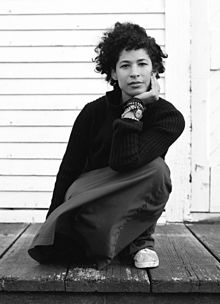Third-wave feminism is an iteration of the feminist movement. It began in the United States in the early 1990s and continued until the rise of the fourth wave in the 2010s. Born in the 1960s and 1970s as members of Generation X and grounded in the civil-rights advances of the second wave, third-wave feminists embraced individualism in women and diversity and sought to redefine what it meant to be a feminist. The third wave saw the emergence of new feminist currents and theories, such as intersectionality, sex positivity, vegetarian ecofeminism, transfeminism, and postmodern feminism. According to feminist scholar Elizabeth Evans, the “confusion surrounding what constitutes third-wave feminism is in some respects its defining feature.”
The third wave is traced to the emergence of the riot girl feminist punk subculture in Olympia, Washington, in the early 1990s, and to Anita Hill’s televised testimony in 1991—to an all-male, all-white Senate Judiciary Committee—that African-American judge Clarence Thomas, nominated for and eventually confirmed to the Supreme Court of the United States, had sexually harassed her. The term third wave is credited to Rebecca Walker, who responded to Thomas’s appointment to the Supreme Court with an article in Ms. magazine, “Becoming the Third Wave” (1992). She wrote:
“So I write this as a plea to all women, especially women of my generation: Let Thomas’ confirmation serve to remind you, as it did me, that the fight is far from over. Let this dismissal of a woman’s experience move you to anger. Turn that outrage into political power. Do not vote for them unless they work for us. Do not have sex with them, do not break bread with them, do not nurture them if they don’t prioritize our freedom to control our bodies and our lives. I am not a post-feminism feminist. I am the Third Wave.”
The rights and programs gained by feminists of the second wave served as a foundation for the third wave. The gains included Title IX (equal access to education), public discussion about the abuse of women, access to contraception and other reproductive services (including the legalization of abortion), the creation and enforcement of sexual-harassment policies for women in the workplace, the creation of domestic-abuse shelters for women and children, child-care services, educational funding for young women, and women’s studies programs.
Feminist leaders rooted in the second wave such as Gloria Anzaldúa, bell hooks, Cherríe Moraga, Audre Lorde, Maxine Hong Kingston, and other feminists of color, sought to negotiate a space within feminist thought for consideration of race. Cherríe Moraga and Gloria E. Anzaldúa had published the anthology This Bridge Called My Back (1981), which, along with All the Women Are White, All the Blacks Are Men, But Some of Us Are Brave (1982), edited by Akasha (Gloria T.) Hull, Patricia Bell-Scott, and Barbara Smith, argued that second-wave feminism had focused primarily on the problems of white women. The emphasis on the intersection between race and gender became increasingly prominent.
In the interlude of the late 1970s and early 1980s, the feminist sex wars arose as a reaction against the radical feminism of the second wave and its views on sexuality, therein countering with a concept of “sex-positivity” and heralding the third wave.

